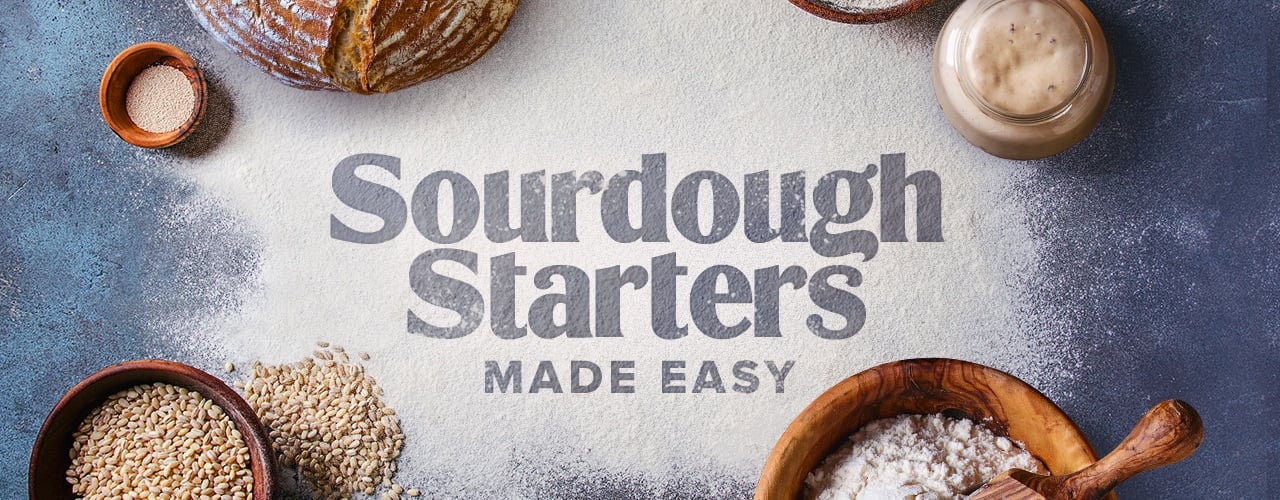Composed of fermented flour and water, a sourdough starter is a leavening agent that utilizes naturally occurring yeasts and bacteria to cause baked goods to rise. While it's most commonly used to make the type of bread we know as sourdough, you can use a sourdough starter instead of yeast or baking soda to make delicious pizza dough, cinnamon rolls, and cookies. Whether you’re starting a bakery or operating a restaurant, learning how to make a sourdough starter will set you above your competition. We explain the basics about sourdough starters, how to make them, and how to keep them alive and usable.
How to Make Sourdough Starter
Use the following video to learn how to make your own sourdough starter:
Sourdough Starter Recipe
Bread leavened with a sourdough starter offers flavor complexity and digestive benefits from the fermentation process. Read on to learn how to make a sourdough starter.
How Does Sourdough Starter Work?

Sourdough starters begin working when you mix liquid and flour. Mixing liquid into flour activates the friendly bacteria and wild yeast living in both your flour and your surrounding environment. Once activated, these microorganisms produce carbon dioxide bubbles, which make your bread rise. Additionally, they generate flavor-rich lactic and acetic acids in your bread.
Because it is an entirely natural process, sourdough starters take longer to leaven bread than store-bought yeasts. The extended fermentation time improves the flavor and texture of the bread. Additionally, bread leavened by a sourdough starter contains high volumes of folate, antioxidants, and comparatively lower phytate levels, which help the body absorb nutrients.
What Special Equipment Do I Need?
- Non-Reactive Container - A non-reactive container is essential for storing your sourdough starter. We recommend using a non-reactive container made of see-through material to observe your sourdough starter’s progress. Select a minimum 1-quart capacity container to provide space for your sourdough starter to expand.
- Baker’s Portion Scale - You need a baker’s portion scale to ensure accurate ratios. Measuring cups leave too great a margin of error.
Sourdough Starter Ingredients
- Whole grain flour contains wild yeast, which is vital for giving your sourdough starter life. There are many types of flour to choose from, so select the whole-grain flour that meets your flavor preference.
- Water between 68-70 degrees Fahrenheit creates a welcoming environment for good bacteria and wild yeast to live and grow. While some baking aficionados swear by distilled water, tap water will normally suffice. If your tap water has a chemical odor indicating heavy treatment, opt for distilled water.
Sourdough Starter Directions
Following a sourdough starter recipe is a lengthy, rather than complex, process. Since it is a living organism, cultivating a sourdough starter is much like growing a plant or caring for a pet; you have to feed and water it. Follow our step-by-step sourdough starter recipe instructions and cultivate a healthy and effective sourdough leavening agent.
Day 1

To set up your sourdough starter, follow the steps below:
- Weigh 113 grams (just shy of 1 cup) of whole wheat flour and 113 grams (1/2 cup) of room temperature water.
- Combine flour and water in 1-quart capacity, see-through, non-reactive container.
- Stir until no dry flour remains.
- Loosely cover container.
- Leave mixture to rest for 24 hours. The room it occupies should be around 70 degrees Fahrenheit.
What Should a Sourdough Starter Look Like on Day 1?
On the first day, a sourdough starter should look like a wet dough with thoroughly incorporated flour.
What Should a Sourdough Starter Smell Like on Day 1?
On day one, the new sourdough starter will have a minimal aroma. It should smell like fresh, wholesome grains.
Day 2
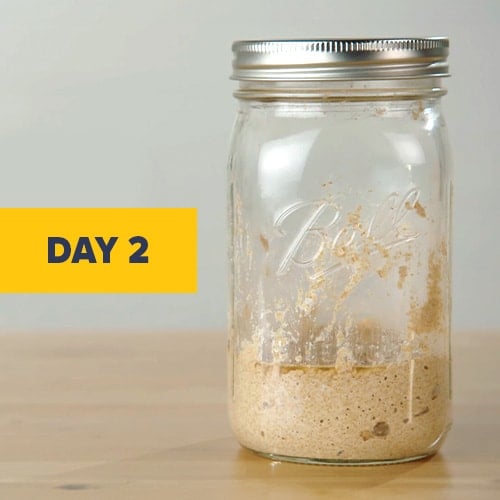
On the second day, follow these steps to continue developing your sourdough starter:
- Whether you begin to see bubbling or your starter is still dormant, discard 113 grams (approximately 1/2 cup).
- Add 113 grams of your chosen flour and 113 grams of water.
- Mix ingredients.
- Let rest at room temperature for 24 hours.
What Should a Sourdough Starter Look Like on Day 2?
Your sourdough starter may have slightly expanded or formed small bubbles by the second day, but it is perfectly normal for no activity to have occurred.
What Should a Sourdough Starter Smell Like on Day 2?
There should be no strong smells coming from your sourdough starter on day two.
Day 3
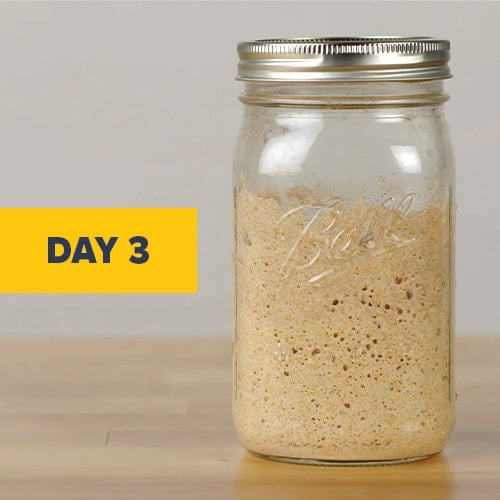
By day three, it's time to increase the sourdough starter’s feeding schedule to twice daily and optimize its feeding method.
- Before each feeding, stir thoroughly.
- Once stirred, reserve 113 grams of starter and discard remainder.
- Mix 113 grams of flour and 113 grams of water into 113 grams of remaining sourdough starter.
- Cover mixture and leave it to rest for 12 hours at room temperature before repeating.
What Should a Sourdough Starter Look Like on Day 3?
A sourdough starter should start showing visible signs of activation, such as bubbling or expansion, on day three.
What Should a Sourdough Starter Smell Like on Day 3?
A sourdough starter should have a fresh, fruity aroma on the third day.
Days 4, 5, & 6
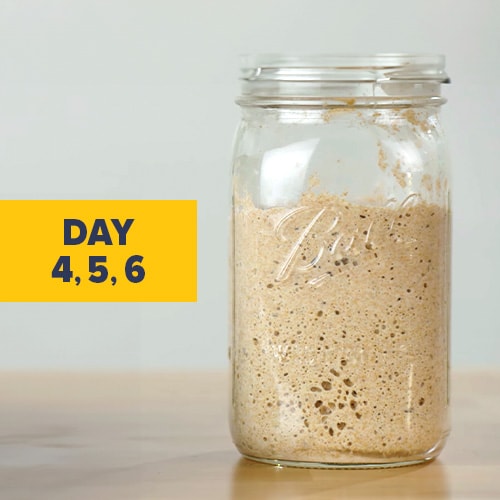
The steps for activating your sourdough starter on days four, five, and six are to repeat the steps from day three.
What Should a Sourdough Starter Look Like on Days 4, 5, & 6?
By day five, the sourdough starter should have at least doubled in volume. Look for signs of activation, such as multiple bubbles and small pools of surface water containing tiny bubbles.
What Should a Sourdough Starter Smell Like on Days 4, 5, & 6?
The sourdough starter should release acidic essences that are tangy but not overpowering by days 4, 5, and 6.
Day 7

Evaluate your sourdough starter to determine your next steps. If your sourdough starter contains few bubbles and has barely expanded, repeat the steps from days 3-6 until your starter is bubbly and ready for use.
Don’t be discouraged if it takes several weeks for your starter to activate completely. Remember, sourdough starters are dependent on the natural bacteria in your environment. If you live in an arid climate, expect your starter to take longer to activate than if you live in a humid or foggy location.
Back to TopHow to Use Sourdough Starter

Here are the steps you need to take before you bake with your ripe sourdough starter:
- Feed your starter its normal diet of 113 grams of flour and 113 grams of water.
- Allow your sourdough starter to come to an active, bubbling state by leaving it to rest at room temperature for six to eight hours after you feed it.
- Bubbles should still be breaking the surface when you incorporate your sourdough starter into your recipe. The bubbles allow your sourdough starter to act as a fermented, natural leavening agent.
How Do I Know When My Sourdough Starter Is Ready to Use?
In baker's terms, a sourdough starter that is ready for use is considered “ripe”. Your sourdough starter is ripe when it doubles in size six to eight hours after being fed. To easily track your starter's expansion, place a rubber band around its container at the fill line. Then, feed your sourdough starter. Six hours later, check to see if the rubber band is now marking your sourdough starter’s midpoint. If it is, your sourdough starter is ripe and ready for use.
How to Store Sourdough Starter
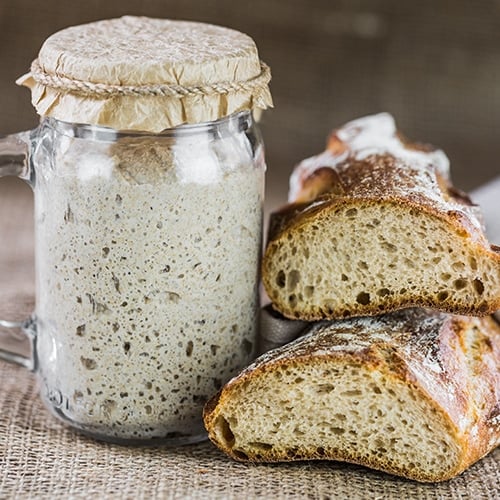
With proper storage and maintenance, your sourdough starter will live for decades. You can store your ripe sourdough starter at room temperature or in your fridge. Regardless of where you store your sourdough starter, you’ll need to continue feeding it. While your sourdough starter will usually revive even if it is left unfed in the back of your refrigerator for months, it will take time and care to bring it back to a ripe state. Discover the feeding schedule for each storage method below to maintain your sourdough starter.
How to Store Sourdough Starter in the Fridge
To store a sourdough starter in the fridge, place it in a nonreactive jar with a tight sealing lid and follow a weekly feeding schedule. The sourdough starter should rest on the counter for 1 to 2 hours after being fed so it can begin bubbling before it is returned to the fridge.
How to Store Sourdough Starter on the Counter
To store a sourdough starter on the counter, cover the nonreactive container with fabric and a rubber band or with parchment paper and the screw ring of a jar. Sourdough starters stored at room temperature remain highly active and require feeding every 12 hours. Since it is harder to keep unrefrigerated sourdough starters active, we recommend refrigerating your sourdough starter unless you are using it too frequently to maintain refrigeration.
How to Feed Sourdough Starter
If you want to keep your sourdough starter in a ready-to-use state, follow the appropriate feeding schedule for your storage method. Here are the simple steps for feeding a sourdough starter:
- First, measure 113 grams of the starter and separate it from the rest.
- Discard or bake with the remaining sourdough starter.
- Feed the 113 grams of sourdough starter by thoroughly mixing in 113 grams of water and 113 grams of flour.
How Do I Know If My Sourdough Starter Is Bad?

Similar to the kombucha fermentation process, cultivating healthy bacteria can sometimes give rise to bad ones. Here is how you can tell if your sourdough starter is bad:
- Smell: If your sourdough starter smells like acetone, it has likely gone bad. While your sourdough should smell sour, it should be a clean sour smell that is strong but not unpleasant.
- Appearance: If your sourdough starter is visibly moldy or tinted with orange and/or pink, then it has gone bad.
Note: If your sourdough starter is left unfed, the liquid layer on top of your starter will turn from clear to dark. This doesn’t mean your starter is bad; it’s just hungry! Give your sourdough starter a meal, and the liquid will return to a clear state.
Sourdough Starter FAQ

Developing a sourdough starter is a great way to set your restaurant or bakery apart. Because sourdough starters depend on local strains of yeast and bacteria, no two sourdough starters are exactly alike. Your sourdough starter will carry the unique flavor of both your region's flora and fauna and your restaurant’s specific microculture, resulting in bread that is truly your own. We've created a guide explaining the terms used in sourdough baking to help you get started.
What Is Leavening?
Commonly referred to as a leavening agent, leavening is the ingredient that makes baked goods rise. Leavening agents exist in both chemical and natural forms. Baking soda and baking powder are examples of chemical leavening agents. They are best suited to bakers’ confectionery such as cakes, doughnuts, and cookies. Yeast and sourdough starters are natural leavening agents used in loaves of bread, dinner rolls, and bagels.
What Does Sourdough Bread Taste Like?
Sourdough bread has a characteristically "sour" taste because sourdough starters are acidic. Bread leavened with a sourdough starter will have a complex flavor and porous texture that is simultaneously airy and chewy. Much like a fine wine, a sourdough starter only improves with age and will deliver more flavorfully robust and texturally light loaves over time. While all sourdough-leavened loaves of bread have similar textures and carry an acidic flavor, there isn't one kind of sourdough-leavened bread. Sourdough is famously associated with San Francisco's unbleached flour sourdough loaves. However, you can use your sourdough starter to make a wide variety of bread types, such as pumpernickel, whole wheat, or barley.
Preferment Definition
Preferment is a generic term used to describe the process of individually fermenting a portion of a bread loaf’s ingredients before adding them to the rest of the ingredients. Some varieties of preferments, such as pate fermentee, biga, and poolish, still use a commercial yeast strain to help leaven bread. In contrast, sourdough and levain are preferments that use an entirely natural leavening process.
Sourdough Starter vs Yeast
Both sourdough starters and yeast are used to leaven baked goods, but they are not the same substance and offer different benefits. The yeast used in baking is called Saccharomyces cerevisiae, a Latinized Greek word meaning "sugar-fungus" because it eats sugar and converts it into carbon dioxide. The carbon dioxide that baking yeast releases gives baked goods light and doughy textures. A sourdough starter is a natural fermentation mixture of flour and water that captures wild yeast and bacteria from the environment. Unlike baking yeast, which provides a quick rise, a sourdough starter requires a longer fermentation process, resulting in a more complex and tangy taste. Additionally, sourdough starters enhance the nutritional value of bread by breaking down gluten and making it easier to digest.
Back to TopWhile the steps may seem lengthy, cultivating a sourdough starter is a long-term investment that will pay off for years if properly maintained. Use your sourdough starter to make everything from sourdough bagels to tangy donuts. Since each sourdough starter is unique, you'll offer guests a flavor they truly can't get anywhere else.
